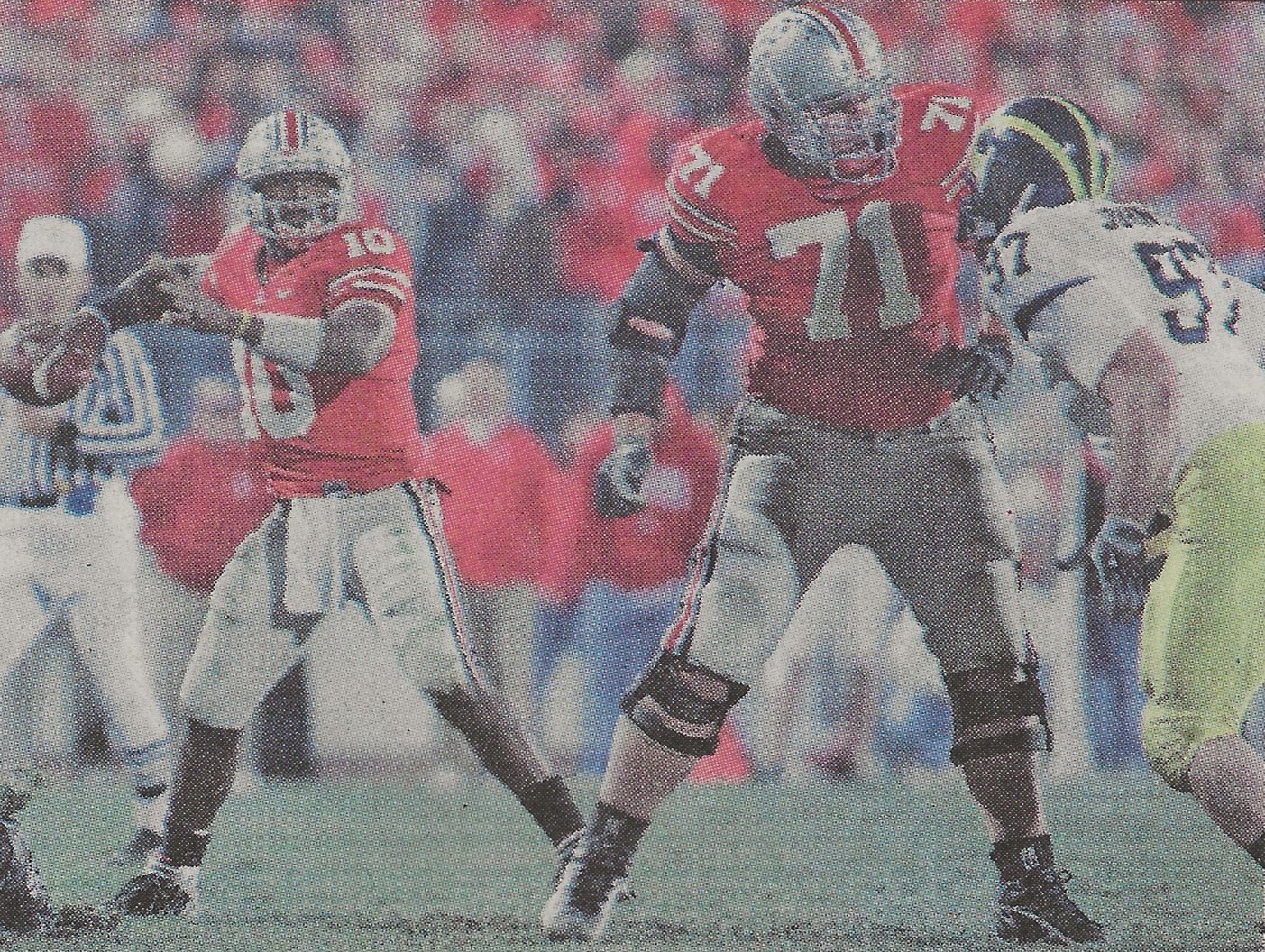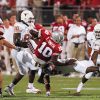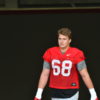
With the return of football up in the air, now serves as a perfect time for reflection on the history of football, and the strategic evolution of the game. To do that, the film study will be spending the offseason looking back at classic Ohio State games. Today’s film study revolves around Ohio State’s 2006 victory over Michigan, 42-39. Video is from this cut-up. Last week’s film study can be found here.
Often in college football, as with everything, the passage of time can erode opinions of coaches, players and teams and turn nuanced assessments into far more basic, and often incorrect memories of what those coaches, players, or teams were like. Since Jim Tressel’s departure from Ohio State following the 2010 season, his tenure in Columbus has experienced this sort of erosion in the minds of many fans and analysts, specifically around the style of play of his offense.
This shift can be summed up pretty easily with the ever-moving definition of “Tresselball,” which originally described Tressel’s “score early and then sit on the lead” approach to offense. In the years since its creation, however, Tresselball has come to define Tressel’s entire approach, marking the coach as ultra-conservative at all times, with a focus on offense exclusively as a way to keep the ball away from the opposing offense.
In some seasons, usually when the Buckeyes were without a decent offensive talent base, that was the case. In others, however, Tressel doesn’t get nearly the kind of recognition he deserves for building elite, electrifying offenses that could score at any moment, only to revert into that true Tresselball, grabbing a lead with high-flying offense only to go into a shell to avoid any serious mistakes.
The 2006 Ohio State offense was much more the latter than it was the former, and could honestly be considered one of the best offenses in school history were it not for the immediate influx of points that came after Tressel in the form of Urban Meyer.
Led by Heisman winning quarterback Troy Smith, wideout Ted Ginn and both Chris Wells and Antonio Pittman out of the backfield, the 2006 edition of the Buckeyes may have been the most explosive offense of Tressel’s tenure. They could score almost at will, in pretty much any way, and were operating out of scheme that, when working, allowed them to spread the field and punish defenses for overadjusting to try to stop one of the several playmakers on the offense.
In the first 30 minutes of Ohio State-Michigan 2006, dubbed the “game of the century” by analysts entering the matchup, the good version of offensive coordinator Jim Bollman’s scheme showed up. The Buckeyes were playing open and loose, taking what was given to them by the Michigan defense, and, most importantly, just going with the flow of the game. Smith was hot to open the game, so the often run-happy Bollman switched his ways and rode the Heisman quarterback to the tune of 26 first half passes, 21 of which found a Buckeye wideout for 241 yards and three touchdowns when the teams went to the locker room at the half.
“I think it’s just the idea that we’re going to take what the defense gives us,” said freshman wideout Brian Hartline. “And if they want to double up on (Anthony) Gonzalez and Teddy (Ginn Jr.) and everyone else, then we’re going to git (Brian) Robiskie and myself and we’re going to move down the field on you. I think it’s pretty hard to find enough DBs to cover us all.”
That seemed to be Ohio State’s exact gameplan, from the first snap of the first half. Smith moved the ball around with ease, spreading it around to all five of his primary receivers, while the rushing attack took a bit of a backseat with Michigan loading up the box to start the game.
The fireworks kicked off early for the Buckeyes, responding to an excellent Michigan opening drive. With four wide receivers and a tight end on the field, Smith took the snap from a formation that Ohio State liked quite a bit in 2006, primarily because of the way that it highlighted Ginn, using the threat of a bubble screen to suck the defense in. That decoy is present on this play, with Smith rolling to the right and Ginn selling a route to the flats to drag in a defender, which he does.
From there, with Michigan sending two rushers, it’s all about finding the open target for Smith. The line picks up the blitz nicely, and with a cool high-low concept that sees a cross from the slot and a post from Roy Hall out of the No. 1 spot on the outside. The other outside receiver is just running a curl, in the case of press man coverage. Michigan is in man but not in press man, giving an extra cushion because of the yards to go on third and long. With that extra cushion, Hall is able to rub right underneath his cornerback to shield him from the ball, and Smith hits him in stride for an easy catch.
Smith finds Hall again later in the drive, with the Buckeyes again using a cool spread concept to punish Michigan’s man coverage. With five receivers wide, this play is designed to go to Hall all the way, as outside receiver to the playside is screening Hall’s defender with a slant right into him to create a cluster of defenders. Smith’s read is just to see if that defender gets caught, which he does, and Smith fires off a pass as soon as he sees it for a wide open touchdown. This isn’t groundbreaking, but it certainly isn’t classic Bollman, to say the least.
Nor is this series of plays in the second quarter to open a drive, the first of which sees this really cool quarterback keep, again utilizing that weird, offset empty backfield formation that puts Ginn even with Smith out in the slot. Instead of a screen fake on this one, Ginn darts inside, with the entire line blocking down towards the short side of the field, selling a handoff to Ginn to the linebackers, who bite on the fake. Smith, however, fakes that handoff, cutting right outside of the unblocked defensive end (it’s unclear if this is a read option, but my guess is no. If it was, that end is being read by Smith) and into open space vacated by the linebackers.
It doesn’t go for much here, but this is a very nice setup play to make those linebackers think, and it serves as a nice workaround to run against that heavy front that Michigan was showing to try to stop Pittman and Wells.
A play later, after a quarter of wide open spread offense and passing, Bollman hits Michigan with the power, and all it takes is one sloppy tackle attempt for Wells to gash the Wolverines for six. Michigan comes out with just two linebackers on the field, and a four man front to match Ohio State’s six man offensive front thanks to the inclusion of a tight end. With even numbers in the box, Ohio State is finally able to run comfortably, which it hadn’t really been able to do up to this point.
However, because of an atrocious block on the far left side of the line, that numbers advantage quickly goes away, as a Michigan end breaks right through the line and into the backfield. Luckily for the Buckeyes, Wells makes a spectacular play, and the rest of the line’s seal is good, leaving Wells with just one linebacker and one safety in a position to stop him. He hits the hole and picks up a really nice block from Kirk Barton, who does a very good job of thinking on his feet and picking up that linebacker in the cutback lane. From there, it’s just about Wells being more talented than anyone trying to tackle him.
Save for that run, however, Ohio State found almost all of its success in the first half in the air, including on the next drive, when Smith finds Ginn on a beautiful play action for a touchdown. Unlike a lot of the other passes, this is coming from a distinctly old school look, with everybody on the line, including Ginn, who lines up with his hand in the grass at the end of the line. Ohio State runs mass protection, keeping everyone else in to block while Ginn runs the only route, to keep Smith clean after the play action fake drags those linebackers and safeties in.
Ginn is just running a skinny post, looking to catch the defense off guard with his speed before they realize that Smith didn’t actually hand the ball off. It doesn’t work perfectly because he’s still covered pretty well, but he’s open enough that a good throw from Smith beats the coverage. Again, this is a really cool blend of power football and spread concepts, getting that talent into space. More of this from Bollman in general, and Tressel probably has a few more wins under his belt.
In the second half, however, the Buckeyes did just as they had so many times before under Tressel, reverting into a much more run focused shell, looking to control the ball and prevent Michigan’s offense from being on the field enough to erase the 28-14 Buckeye lead at the half. It all just falls apart. The rushing attack becomes essentially the entire offense, as Smith goes 1-for-7 passing in the third quarter, with little to no creativity in the play design. Ohio State looked a lot like a team that had showed all of the firepower it wanted to show, and was ready to just wrap the game up in bubblewrap and be done with it.
That works against quite a few teams, but it doesn’t work against Michigan, and were it not for a great effort from Antonio Pittman on a big touchdown run, the Wolverines would’ve taken the lead during this dry spell from the Buckeyes, because as it turns out, conservative offense doesn’t really work when you’re also constantly turning the ball over, as Ohio State was.
It wasn’t until the fourth quarter, while clutching to a 35-31 lead, that Ohio State realized it still had all of that firepower, and could use it to put the game away.
That meant a return to the spread concepts that worked so well to start the game, like this quick hitter to Ginn on a short curl. The Buckeyes are five-wide again here, with Smith eyeing Ginn the whole way despite the run route happening on the other side of the field, in what looks very similar to that first quarter touchdown play, albeit with a deep threat out of the backside slot rather than a quick curl. Michigan is in man coverage again, and cornerback Morgan Trent has absolutely no hope against Ginn, who turns the short pass into a big gain.
This was where Ohio State was at its best in this game. Michigan could match the Buckeyes up front, but outside of cornerback Leon Hall, nobody in this backfield could keep up with Ohio State’s wideouts.
Even though this drive ended in another turnover after what seemed like the 30th bad snap of the game, Ohio State seemed to take the correct lesson away from it: stay creative, stay loose, and just do what works.
A few minutes later, still holding onto that lead, the Buckeyes stuck with what worked, broke out some creative run plays to get around the Michigan front seven, and worked down into the red zone, giving Smith one more chance to make a play to the perimeter, right at the weak part of the Wolverine defense.
Just as it had been all game, when it came down to this single coverage matchups in the passing game, Michigan had no hope of stopping it, regardless of the receiver on the end of the pass.








